View in other NatureServe Network Field Guides
NatureServe
Montana
Utah
Wyoming
Idaho
Wisconsin
British Columbia
South Carolina
Yukon
California
New York
Persistent-sepal Yellow-cress - Rorippa calycina
State Rank Reason (see State Rank above)
Rorippa calycina is a regional endemic currently known only from four Montana records. The species was last observed in Montana more than 30 years ago. Surveys are needed.
General Description
Persistent-sepal Yellow-cress is a rhizomatous perennial with spreading or lax stems that are 1-4 dm long. The alternate leaves are 3-7 cm long and have coarsely toothed to shallowly lobed margins. Foliage is roughened or sparsely covered with stiff hairs. Several stalked flowers are borne on the ends of terminal branches that arise from the axils of upper leaves, forming an open inflorescence. Each flower has 4 separate sepals, 4 separate, light yellow petals that are ca. 4 mm long, and 4 long and 2 short stamens. The sepals tend to remain in place until the fruit is nearly mature. The ascending egg-shaped capsules, or siliques, are 2-5 mm long and soft-hairy.
Phenology
Flowering and fruiting occur from May through July or beyond, however fruits are important for identification.
Diagnostic Characteristics
Rorippa sinuata has elongate, glabrous fruits that exceed 5 mm in length, deciduous sepals, and round, glassy, ball-like hairs on the leaves. R. curvipes often has white petals, deeply pinnate leaves and glabrous to sparsely hairy fruits and leaves. All other species of Rorippa in this region are taprooted annuals or biennials with longer, more erect stems and fruits that are either round or narrowly elongate (Fertig and Welp 1998).
Species Range
Montana Range
Range Descriptions
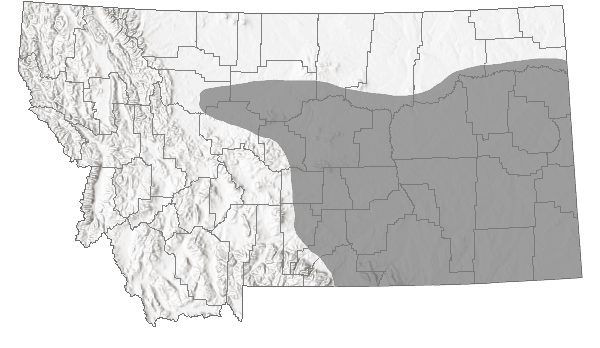
 Historical
Historical
Range Comments
Rorippa calycina is a regional endemic of south-central Montana, western North Dakota, and central Wyoming, with a disjunct population 2,500 miles to the north on the Arctic coast of Canada's Northwest Territories (Mulligan and Porsild 1966).
Observations in Montana Natural Heritage Program Database
Number of Observations: 5
(Click on the following maps and charts to see full sized version)
Map Help and Descriptions
Relative Density
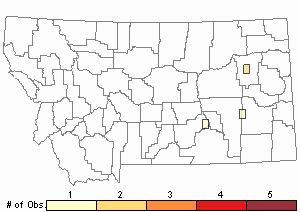
Recency
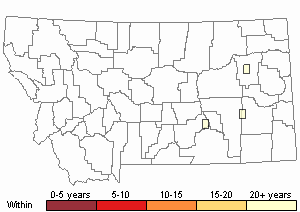
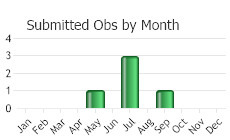
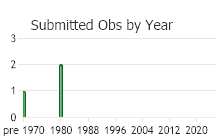
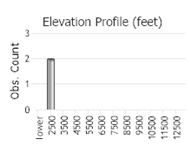 (Observations spanning multiple months or years are excluded from time charts)
(Observations spanning multiple months or years are excluded from time charts)
Habitat
Persistent-sepal yellow-cress inhabits sparsely vegetated, moist sandy to muddy banks of streams, stock ponds and man-made reservoirs near the high water line. Topographic features and water levels appear to be more important than geologic substrates in determining where this species grows (Fertig and Welp 1998). Its habitat is usually sparsely vegetated with bunchgrasses, early successional or weedy forbs, and scattered shrubs. In Wyoming, it occurs mostly on semi-disturbed or recently flooded openings in small inlets or bays with scattered clumps of Hordeum jubatum, Poa secunda, Elymus smithii and a variety of native and exotic early successional forbs. Occasional populations can also be found in openings in grassy streambanks, in barren patches among thickets of Salix exigua or Tamarix chinensis (salt cedar), and on the banks of small playa lakes (Fertig and Welp 1998).
Ecological Systems Associated with this Species
Ecology
Fluctuating water levels are key to creating and maintaining the shoreline flats habitat favored by this plant. In Wyoming, nearly all known occurrences are found on seasonally flooded mudflats or sandy beaches, in small inlets of reservoirs or along the banks of ponds and small streams (Fertig and Welp 1998). During high water years, these mudflats may remain inundated throughout the growing season. This plant is conspicuously absent from rocky shores or steep sandy to muddy banks (with slopes over 2-3%). Nearly all of the plant species commonly associated with persistent-sepal yellow-cress are adapted to early successional or disturbed habitats, and a number of them are not non-native (Fertig and Welp 1998).
Extensive surveys in Montana have failed to relocate this plant. Populations in Wyoming vary from sparse to locally abundant depending on seasonal flooding, the amount of competing vegetation cover, and disturbance. Numbers are highest during years with low water levels, but the species appears able to persist during periods of flooding by means of perennating rhizomes or a seedbank. High seed production, asexual reproduction and self-compatibility are adaptations allowing the species to colonize bare ground.
POLLINATORS The following animal species have been reported as pollinators of this plant species or its genus where their geographic ranges overlap:
Bombus rufocinctus (Thorp et al. 1983).
Management
Rorippa calycina appears able to persist under certain reservoir conditions. Fluctuating water levels are key to creating bare substrate needed by this species, and maintaining reservoirs at a constant level could lead to loss of habitat and an increase in competing vegetation. Permanently raising water levels can wipe out existing, low-lying colonies, but should create new habitat higher on the bank as long as some fluctuation is maintained. Of course, colonization of newly exposed habitat also depends on maintenance of a seedbank or seed dispersal from nearby populations.
Competition from exotic plants, especially salt cedar, is a serious threat to this plant at several reservoir sites in Wyoming, including Yellowtail Reservoir on Bighorn Canyon NRA. Dense growth of salt cedar can shade out the species and stabilize shoreline habitats. Spotted knapweed (Centaurea maculosa) is also present at the margins of the species' habitat at some locations, although it is not nearly as widespread at this time as salt cedar. Leafy spurge (Euphorbia esula) is invading along the Yellowstone River.
Fertig and Welp (1998) reported little evidence of grazing or browsing on leaves or stems, however, they noted that heavy shoreline trampling could affect habitat suitability. Shoreline trampling was thought to be is the most likely cause for extirpation of the McCone County occurrence in Montana (Heidel 1994).
Stewardship Responsibility
Threats or Limiting Factors
STATE THREAT SCORE REASON
Threat impact not assigned because threats are not known (MTNHP Threat Assessment 2021).
References
- Literature Cited AboveLegend:
 View Online Publication
View Online Publication MTNHP Threat Assessment. 2021. State Threat Score Assignment and Assessment of Reported Threats from 2006 to 2021 for State-listed Vascular Plants. Botany Program, Montana Natural Heritage Program, Helena, Montana.
MTNHP Threat Assessment. 2021. State Threat Score Assignment and Assessment of Reported Threats from 2006 to 2021 for State-listed Vascular Plants. Botany Program, Montana Natural Heritage Program, Helena, Montana. Thorp, R.W., D.S. Horning, and L.L. Dunning. 1983. Bumble bees and cuckoo bumble bees of California (Hymenoptera: Apidae). Bulletin of the California Insect Survey 23:1-79.
Thorp, R.W., D.S. Horning, and L.L. Dunning. 1983. Bumble bees and cuckoo bumble bees of California (Hymenoptera: Apidae). Bulletin of the California Insect Survey 23:1-79.
- Additional ReferencesLegend:
 View Online Publication
View Online Publication
Do you know of a citation we're missing? Fertig, W. and L. Welp. 1998. Status report on persistent sepal yellowcress (Rorippa calycina) in Wyoming. [Unpublished report to the Bureau of Land Management Wyoming State Office.] Wyoming Natural Diversity Database, Laramie, Wyoming. 106 pp.
Fertig, W. and L. Welp. 1998. Status report on persistent sepal yellowcress (Rorippa calycina) in Wyoming. [Unpublished report to the Bureau of Land Management Wyoming State Office.] Wyoming Natural Diversity Database, Laramie, Wyoming. 106 pp. Heidel, B.L. 1994. Sensitive plant species survey in Garfield and McCone Counties, Montana. Unpublished report to the Bureau of Land Management. Montana Natural Heritage Program, Helena, Montana. 58 pp. plus appendices.
Heidel, B.L. 1994. Sensitive plant species survey in Garfield and McCone Counties, Montana. Unpublished report to the Bureau of Land Management. Montana Natural Heritage Program, Helena, Montana. 58 pp. plus appendices. Heidel, B.L. 2001. Conservation status of Rorippa calycina (persistent-sepal yellowcress) in Montana. Report to U.S. Fish and Wildlife Service. Montana Natural Heritage Program, Helena, MT.
Heidel, B.L. 2001. Conservation status of Rorippa calycina (persistent-sepal yellowcress) in Montana. Report to U.S. Fish and Wildlife Service. Montana Natural Heritage Program, Helena, MT. Lesica, P., M.T. Lavin, and P.F. Stickney. 2012. Manual of Montana Vascular Plants. Fort Worth, TX: BRIT Press. viii + 771 p.
Lesica, P., M.T. Lavin, and P.F. Stickney. 2012. Manual of Montana Vascular Plants. Fort Worth, TX: BRIT Press. viii + 771 p. Lesica, P., M.T. Lavin, and P.F. Stickney. 2022. Manual of Montana Vascular Plants, Second Edition. Fort Worth, TX: BRIT Press. viii + 779 p.
Lesica, P., M.T. Lavin, and P.F. Stickney. 2022. Manual of Montana Vascular Plants, Second Edition. Fort Worth, TX: BRIT Press. viii + 779 p. Mulligan, G. A. and A. E. Porsild. 1966. Rorippa calycina in the Northwest Territories. Canadian Journal of Botany 44:1105-1106.
Mulligan, G. A. and A. E. Porsild. 1966. Rorippa calycina in the Northwest Territories. Canadian Journal of Botany 44:1105-1106. Rollins, R. C. 1993. The Cruciferae of Continental North America: systematics of the mustard family from the Arctic to Panama. Stanford University Press, Stanford, California. 976 pp.
Rollins, R. C. 1993. The Cruciferae of Continental North America: systematics of the mustard family from the Arctic to Panama. Stanford University Press, Stanford, California. 976 pp.
- Web Search Engines for Articles on "Persistent-sepal Yellow-cress"





